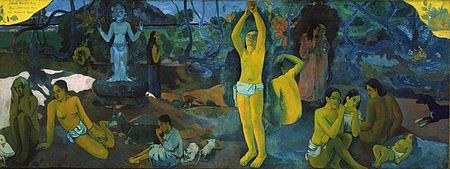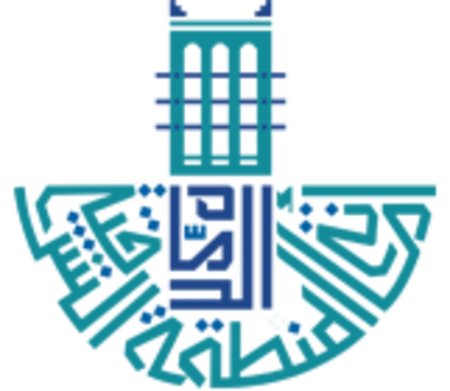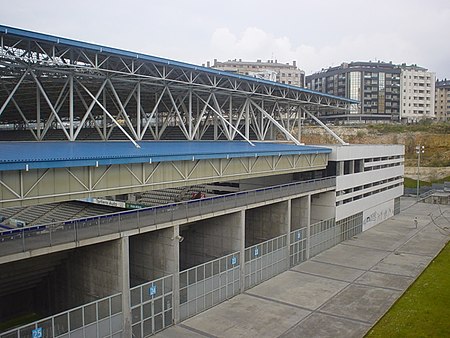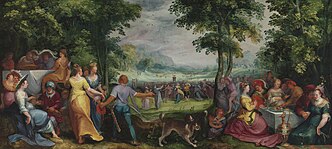Karel van Mander
| |||||||||||||||||||||
Read other articles:

Restaurant in New York, United StatesSerendipity 3Entrance to Serendipity 3, in 2007Restaurant informationEstablished1954; 70 years ago (1954)Food typeDessert, ice creamStreet address225 East 60th StreetCityNew York CityStateNew YorkPostal/ZIP Code10022CountryUnited StatesOther locations500 Boardwalk, Atlantic City, New Jersey 08401Websitehttp://www.serendipity3.com/ Serendipity 3, often written Serendipity III, is a restaurant located at 225 East 60th Street, between Second an…

Not to be confused with Sort Sol (band). A formation of starlings in the marshlands near Tønder, Denmark. Blick of sort sol Sort sol is a murmuration, a flocking behavior that occurs in the marshlands in southwestern Jutland, Denmark, in particular the marsh near Tønder and Ribe. Very large numbers of migratory starlings gather there in spring and autumn when they move between their winter grounds in southern Europe and their summer breeding grounds in Scandinavia and other countries near the …

Former Swedish aerospace manufacturer Volvo AeroIndustryAerospaceFounded1930Defunct2012FateAcquired by GKNSuccessorGKN Aerospace Engine SystemsHeadquartersTrollhättan, SwedenNumber of locationsTrollhättan, Linköping, Kongsberg (Norway), Newington, Connecticut (US)ParentVolvo F-104 on display outside Volvo Aero Volvo RM6B Volvo Flygmotor RM8B Volvo Aero was a Swedish aircraft, guided missiles[1] and rocket engine[2][3] manufacturer. It became GKN Aerospace Engine System…

Yang MuliaFlorentinus Sului Hajang HauM.S.F.Uskup Agung SamarindaGerejaGereja Katolik RomaKeuskupan agungSamarindaPenunjukan5 April 1993(44 tahun, 115 hari)Masa jabatan berakhir18 Juli 2013(64 tahun, 219 hari)PendahuluMichael Cornelis C. Coomans, M.S.F.PenerusYustinus Harjosusanto, M.S.F.ImamatTahbisan imam6 Februari 1976[1](27 tahun, 57 hari)oleh Wilhelmus Joannes Demarteau, M.S.F.Tahbisan uskup21 November 1993oleh Yulius Aloysius Husin, M.S.F.(44…

Pour les articles homonymes, voir Palais des congrès. Palais des congrès de ParisGénéralitésAdresse 2, place de la Porte-MaillotConstruction et ouvertureOuverture 28 février 1974Architecte Guillaume GilletUtilisationSite web palaisdescongresdeparis.comLocalisationCoordonnées 48° 52′ 44″ N, 2° 17′ 00″ ELocalisation sur la carte du 17e arrondissement de ParisLocalisation sur la carte de Parismodifier - modifier le code - modifier Wikidata Le palais de…

坐标:43°11′38″N 71°34′21″W / 43.1938516°N 71.5723953°W / 43.1938516; -71.5723953 此條目需要补充更多来源。 (2017年5月21日)请协助補充多方面可靠来源以改善这篇条目,无法查证的内容可能會因為异议提出而被移除。致使用者:请搜索一下条目的标题(来源搜索:新罕布什尔州 — 网页、新闻、书籍、学术、图像),以检查网络上是否存在该主题的更多可靠来源(…

艾德礼伯爵 阁下The Rt Hon. The Earl AttleeKG OM CH PC FRS联合王国首相任期1945年7月26日—1951年10月26日君主乔治六世副职赫伯特·莫里森前任温斯顿·丘吉尔继任温斯顿·丘吉尔联合王国副首相任期1942年2月19日—1945年5月23日(战时内阁)君主乔治六世首相温斯顿·丘吉尔前任职位创立继任赫伯特·莫里森反对党领袖任期1951年10月26日—1955年11月25日君主乔治六世伊丽莎白二世�…

This article needs additional citations for verification. Please help improve this article by adding citations to reliable sources. Unsourced material may be challenged and removed.Find sources: Hungarian dialects – news · newspapers · books · scholar · JSTOR (May 2013) (Learn how and when to remove this message) Overview of dialects of the Hungarian language by region and country Hungarian languageHungarian alphabet Alphabet ő ű cs dz dzs gy ly ny sz t…

ヨハネス12世 第130代 ローマ教皇 教皇就任 955年12月16日教皇離任 964年5月14日先代 アガペトゥス2世次代 レオ8世個人情報出生 937年スポレート公国(中部イタリア)スポレート死去 964年5月14日 教皇領、ローマ原国籍 スポレート公国親 父アルベリーコ2世(スポレート公)、母アルダその他のヨハネステンプレートを表示 ヨハネス12世(Ioannes XII、937年 - 964年5月14日)は、ロー…

Public charter high school in the United StatesPPEP TEC High SchoolsLocation1840 E. Benson Highway Tucson, ArizonaUnited StatesCoordinates32°10′11″N 110°56′40″W / 32.16966°N 110.944502°W / 32.16966; -110.944502InformationTypePublic Charter High SchoolMottoStriving for Academic ExcellenceEstablished1995[1]School districtPPEP TEC High SchoolsGrades9-12Color(s)Silver, MaroonMascotPumasAffiliationPPEP, Inc.NewspaperThe Rock[2][3]Websitewww.…

Частина серії проФілософіяLeft to right: Plato, Kant, Nietzsche, Buddha, Confucius, AverroesПлатонКантНіцшеБуддаКонфуційАверроес Філософи Епістемологи Естетики Етики Логіки Метафізики Соціально-політичні філософи Традиції Аналітична Арістотелівська Африканська Близькосхідна іранська Буддійсь…

Adam SahakyanNative nameԱդամ ՍահակյանBorn(1996-08-19)August 19, 1996Yerevan, ArmeniaDiedApril 2, 2016(2016-04-02) (aged 19)Nagorno-Karabakh Republic (de facto)BuriedYerablur Military PantheonAllegiance Armenia ArtsakhService/branchArmed Forces of Armenia Nagorno-Karabakh Defence ArmyRankSergeantBattles/warsFour-Day WarAwardsHero of Artsakh Adam Sahakyan (Armenian: Ադամ Սահակյան; 19 August 1996, Yerevan – 2 April 2016, Jrakan) was an Armenian sergeant of …

شركة الزامل للاستثمار الصناعيشركة الزامل للاستثمار الصناعيالشعارمعلومات عامةالبلد السعودية التأسيس 1998 مالنوع شركة مساهمة سعوديةالشكل القانوني شركة مساهمة — شركة عمومية محدودة المقر الرئيسي مدينة الدمام ، السعوديةموقع الويب zamilindustrial.com المنظومة الاقتصاديةالصناع�…

Otl Aicher (1959) Otl Aicher, atau sebenarnya Otto Aicher, (Ulm, Jerman 13 Mei 1922 – Rotis, Leutkirch im Allgäu, 1 September 1991) adalah salah seorang perancang (designer) Jerman yang penting pada abad ke-20 dan dikenal di mancanegara. Biografi Otl Aicher berasal dari sebuah kalangan yang menentang National-Sosialisme dan mengenal Scholl bersaudara dengan baik. Ia adalah anggota bündische Jugend dan menolak untuk bergabung dengan Hitler-Jugend (Perkumpulan Pemuda Hitler). Oleh karena itu p…

Yusuf I de Granada Sultán de Granada[1] El palacio de Comares de la Alhambra fue mandado construir por Yusuf I.Reinado 25 de agosto de 1333-19 de octubre de 1354Predecesor Muhammed IVSucesor Muhammed VInformación personalNacimiento 1318Granada, ( Reino nazarí)Fallecimiento 19 de octubre de 1354Granada, ( Reino nazarí)Sepultura Rauda de la AlhambraFamiliaCasa real Banu NasrPadre Ismaíl IMadre BaharHijos Muhammed VIsmaíl II[editar datos en Wikidata] Yusuf I fue un sultán de…

American politician (born 1952) This article is about the American politician and businessman. For other people with similar names, see Richard Scott (disambiguation). Rick ScottOfficial portrait, 2019United States Senatorfrom FloridaIncumbentAssumed office January 8, 2019Serving with Marco RubioPreceded byBill NelsonChair of the National Republican Senatorial CommitteeIn officeJanuary 3, 2021 – January 3, 2023LeaderMitch McConnellPreceded byTodd YoungSucceeded bySteve Dai…

American actor (1926–2016) Not to be confused with Fritz Wepper. Fritz WeaverBornFritz William Weaver(1926-01-19)January 19, 1926Pittsburgh, Pennsylvania, U.S.DiedNovember 26, 2016(2016-11-26) (aged 90)New York City, U.S.Alma materPeabody High SchoolOccupation(s)Actor, voice artistYears active1956–2016Spouses Sylvia Short (m. 1953; div. 1979); 2 children Rochelle Oliver (m. 1997– …

Place in HungaryNógrád NovohradNógrádLocation of NógrádCoordinates: 47°54′17″N 19°03′06″E / 47.90482°N 19.05157°E / 47.90482; 19.05157Country HungaryCountyNógrádArea • Total29.52 km2 (11.40 sq mi)Population (2004) • Total1,573 • Density53.28/km2 (138.0/sq mi)Time zoneUTC+1 (CET) • Summer (DST)UTC+2 (CEST)Postal code2642Area code35 Nógrád (Slovak: Novohrad; German: Neuburg) …

Part of a series onMachine learningand data mining Paradigms Supervised learning Unsupervised learning Online learning Batch learning Meta-learning Semi-supervised learning Self-supervised learning Reinforcement learning Curriculum learning Rule-based learning Quantum machine learning Problems Classification Generative modeling Regression Clustering Dimensionality reduction Density estimation Anomaly detection Data cleaning AutoML Association rules Semantic analysis Structured prediction Feature…

Stadion Carlos TartiereNama lengkapStadion Carlos TartiereNama lamaStadion Buenavista (1932–1958)LokasiOviedo, SpanyolPemilikConcejo de OviedoOperatorReal OviedoKapasitas22.000 (1932–1982)23.500 (1982–1998)16.500 (1998–2003)PermukaanRumputKonstruksiDibuka24 April 1932Direnovasi1982Ditutup20 Mei 2000Dihancurkan2003ArsitekIldefonso Sánchez del RíoPemakaiReal Oviedo (1932–2000) Stadion Carlos Tartiere adalah sebuah stadion yang terletak di Oviedo, Spanyol. Stadion ini umumnya dipergunak…






